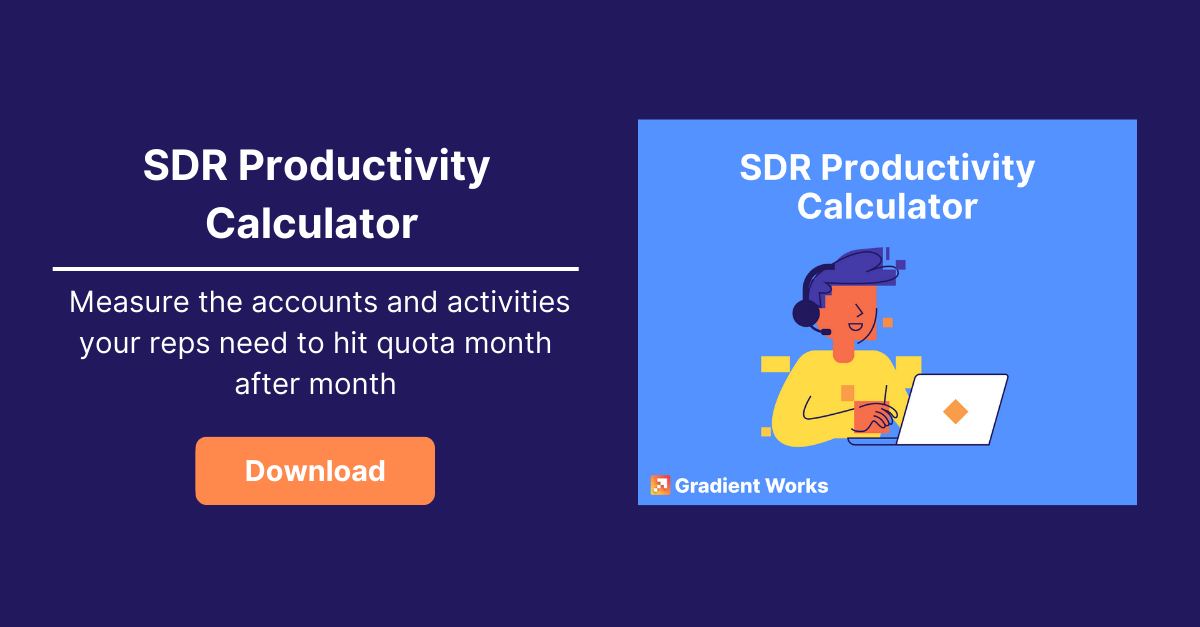How many accounts should sales reps own? We hear this question all the time, and you probably think about it a lot.
It's an important question. If they have too few accounts, your reps won't hit quota. Too many and you won't cover your SAM effectively. And it's complicated by individual rep preferences and abilities.
And of course, this will vary for every company, by product, industry, TAM/SAM size, rep role, etc... There's no universal answer. But, we've got a few way ways to think about it for your team, and hopefully these will help you find that sweet spot.
(BTW, we're talking about account ownership for companies that take an ABM/ABX/ABS approach. If your reps don't own accounts, these concepts still make sense for a leads model. Though we think they should own accounts, not leads.)
Possible account allocation models
Activity Up. Reps have about 2,000 hours per year to work. They'll probably only spend 75% of that (which works out to 1,500 hours per year or 125 hours per month) on actual selling (or supporting, if you're talking about CSMs or AMs).
Given what you know about the activity levels required for your product, how many accounts can a rep reasonably support in 125 hours a month? A large enterprise customer will likely take up more hours than a smaller business. You should be able to estimate these numbers from activity data in Salesforce and your sales engagement tools, and from talking with reps.
It's a simple formula for this calculation:
125 hours per month / # hours per account = Total accounts able to be worked at a time
So if reps spend about 3 hours per month on an account, then 125/3 = 42. They can work 42 accounts at a time.
If you want to read more about a bottoms-up approach like this, take a look at Jon Miller's post here.
Output Down. Given your known conversion rates and ASP, how many accounts do reps need to hit their quota? Here's the formula based on monthly quotas, but you can do this for quarters or years, depending on your model.
You need four data points to start: ASP, individual rep quota, close rate (the percent of SQLs that become C/W deals), and qualification rate (the percent of accounts that become SQLs). Then there are 3 simple calculations.
- Rep quota /ASP = Closed-won deals
- Closed-won deals / close rate = SQLs needed
- SQLs / qualification rate = Total accounts needed
An example: Let's say a ramped rep's quota is $45,000/month and ASP is $15,000. So a rep needs to close 3 new deals a month to hit quota. You have a 50% close rate and a 5% qualification rate. To hit those numbers, you need 160 accounts per month per rep.
- $45,000 quota / $15,000 ASP = 3 closed-won deals
- 3 closed-win / 50% close rate = 6 SQLs needed
- 6 SQLs / 5% qualification rate = 120 accounts needed
If your team or your product are new, this will be just an absolutely wild guess, but you can refine it over time. There's more on this kind of model here.
As usual with bottoms-up and top-down calculations, you should probably attempt to calculate both and see how they line up. In these totally made up examples, they do not match up at all (42 vs 120), but hopefully yours will be closer. If not, you may need to look at some other factors, like how can you increase conversion rates or adjust quota? A topic for a different post.
Dunbar's Number. If you're not familiar, the anthropologist Robin Dunbar suggests we can only maintain about 150 stable social relationships at once. He's an anthropologist, not a salesperson, but the idea makes sense. We know there's a max number of accounts that reps can reasonably focus on regardless of what other calculations may suggest. For example, we've rarely seen reps be successful covering their book when they work on more than 150 accounts at a time, so this seems like a good place to start.
Dynamic Books. No matter what you decide, the number of accounts shouldn't be one-size-fits-all for all reps. We recommend a dynamic account allocation model, coupled with an activity and account penetration SLA. If a rep is touching most accounts every 30 days and working multiple contacts at each account, then they can clearly manage that book and might be able to handle a larger one.
And there's likely always going to be an element of “how many accounts can you manage at the same time?" for reps. Even on the same team, some reps thrive with 150 accounts while others work better with 75 accounts, each producing roughly the same results. That's why dynamic books are so much better than fixed territories.
(If you're thinking "oh yeah dynamic books sounds like a great idea and we should do that!" then you should take a look at the book management software we've built at Gradient Works.)
A few other considerations
An account is "being worked" if there's some reasonable level of activity within the last 30 days. That activity threshold will vary by organization and ICP. Based on that, you should set expectations for what percentage of assigned accounts a rep must work to keep those accounts in their name.
For example, say a rep must be working at least 75% of their assigned accounts to keep them. You'll probably find that most can only keep 100 to 115 accounts. For a purely outbound prospecting role (BDR or SDR), that number may increase to 125 to 150. For AMs and CSMs, those numbers may look a lot different.
But remember that as the number of accounts increases, the level of personalization decreases. And you may end up with reps defaulting to more generic and less effective outreach. So you need to balance the number of accounts a rep can handle with the level of personalization you expect.
Finally, we know that some organizations are reluctant to cap a rep's book at all. The issue with this is that you'll likely run into issues with hoarding, untouched accounts, and imbalanced attainment. If you limit how many accounts a rep can own at one time to a reasonable number, reps are more likely to actively work every account. You're also able to recirculate accounts more easily to reps with smaller books. So generally we recommend upper limits in rep books.
If you're interested in this discussion, take a look at our CEO Hayes Davis' recent post on LinkedIn. A number of sales leaders have commented on how they think about account allocation. We'd love to hear your thoughts!






